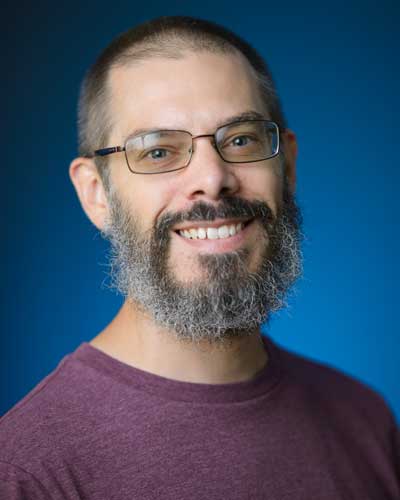
Kurt Shoemaker
Title: Professor of Geology
Subject Area: Geology
Office Location: MAS025A
Phone: (740) 351-3395
Email: kshoemaker@shawnee.edu
EDUCATION
Ph.D. (Geology), Miami University, Oxford OH, 2004
• Dissertation: The tectonomagmatic evolution of the late Cenozoic Owyhee Plateau, Oregon-Nevada-Idaho.
B.A. (History), Shawnee State University, Portsmouth OH, 2022
B.S. (Geology, minor in Chemistry), Mount Union College, Alliance OH, 1995
ABOUT
Dr. Shoemaker is a Professor of Geology in the Department of Natural Sciences at Shawnee State University. Originally a magmatic geochemist studying the origins of basaltic volcanism in the inland northwestern US, he now conducts interdisciplinary research in the upper Ohio Valley with two major focuses: (1) the evolution of the incipient Ohio River system before and during the Pleistocene Epoch (“Ice Age”), and (2) the intersection of geologic setting and phenomena with human history.
TEACHING
Dr. Shoemaker is the recipient of the 2019 SSU Board of Trustees Distinguished Teaching Award.
COURSES TAUGHT (since 2015)
GEOL 1201 Physical Geology & Human Environment
GEOL 1202 Historical Geology
NTSC 1501 Environment & Society
GEOL 2111 Introduction to Geologic Field Methods
GEOL 2203 Mineralogy
GEOL 3205 Igneous & Metamorphic Petrology
GEOL 4206 Structural Geology & Tectonics
GEOL 3100 Field Studies in Regional Geology:
• The American Southwest (Fall 2019)
• The Ozarks (Spring 2019)
• Blue Ridge Mountains (Spring 2018)
• Caves, Karst and Limestone at Mammoth Cave National Park (Spring 2015)
GEOL 3390 Seminar in Geology:
• The Ice Age in the Ohio Valley (Spring 2017)
SCHOLARSHIP
CONFERENCE PRESENTATIONS (since 2015; SSU student co-authors underlined)
Brueseke, M.E. and Shoemaker, K.A. (session conveners), 2021, From the Afar Rift to Alaskan Arcs (and the Oregon Plateau in between): Honoring the Career and Contributions of William K. Hart: Geological Society of America Annual Meeting, Portland OR.
Rogers, S., Boyd, A.N., Shoemaker, K.A., and Erjavec, J., 2019, Shoreline features of Pleistocence Proglacial Lake Tight in Carter County, Kentucky: Geological Society of America Annual Meeting, Phoenix AZ.
Shoemaker, K.A., and Erjavec, J., 2018, Pleistocene seismicity associated with the impoundment of proglacial Lake Tight, Pike County, Ohio: Geological Society of America Annual Meeting, Indianapolis IN.
Boyd, R., Leesburg, J.N., and Shoemaker, K.A., 2017, Stream piracy in the Teays River system prior to the impoundment of Pleistocene Lake Tight: The evolution of the Tygarts Creek and Little Sandy River drainage basins of northeast Kentucky: Geological Society of America Annual Meeting, Seattle WA.
Shoemaker, K.A., 2017, An outrageous hypothesis for the origin of Pleistocene “dunes” in the Ohio Valley at Sandy Springs, Ohio, and Vanceburg, Kentucky: Geological Society of America Annual Meeting, Seattle WA.
Shoemaker, K.A., and Erjavec, J., 2015, Early impoundment history of Pleistocene Lake Tight: New insights from subsurface study of the Teays Formation, Pike County, Ohio: Geological Society of America Annual Meeting, Baltimore MD.
Cooper, J.B., Shoemaker, K.A., and Erjavec, J., 2015, Possible seismites in the Pleistocene Teays Formation, Pike County, Ohio: Geological Society of America Southeastern Section Meeting, Chattanooga TN.
BOOKS, COMMUNITY PRESENTATIONS, MEDIA APPEARANCES, etc. (since 2015)
Protected for Progress: Two Centuries of Floods and Flood Defense at Portsmouth, Ohio. (book, in preparation).
The Floodwalls before The Floodwall: Portsmouth and Flood Defense Prior to the 1936 Flood Control Act: SSU Faculty Research and Teaching Expo, 2024.
This is the Ohio: Life, Death, and Rebirth of the Beautiful River. Documentary film, Morgan Atkinson, producer, 2024.
Flood Proof? SSU College of Arts & Sciences Connecting Classrooms podcast, 2024.
Historical Population Growth and Decline in Greater Portsmouth, Ohio: A Geologic Perspective: SSU Festival of Faculty Achievement, 2023
Scioto Pre-historical: The Ice Age and the Creation of the Ohio River, ca. 750,000 BCE: Southern Ohio Museum Prehistory Lecture Series, 2022.
Greetings from scenic Lake Tight: Understanding an Ice Age lake and its influence on the Ohio Valley: SSU Festival of Faculty Achievement, 2015.
ADDITIONAL INFORMATION
Dr. Shoemaker fears being mauled by a walrus.
